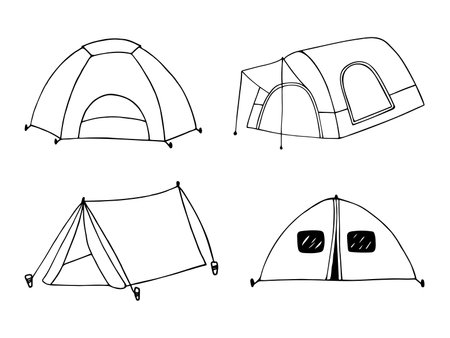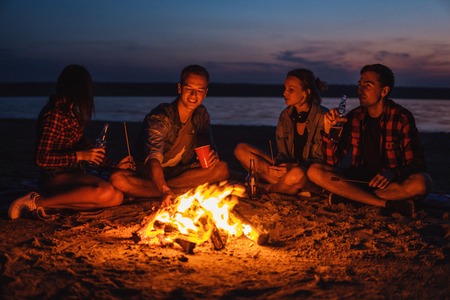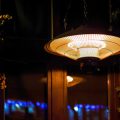1. Understanding the Basics: Lanterns vs. Flashlights
When youre gearing up for a camping trip, lighting is one of the essentials you cant overlook. Whether youre navigating a trail after sunset or setting up camp in the dark, having the right type of light can make all the difference. Two of the most common options are camping lanterns and flashlights—but they each serve different purposes. Lets explore their key differences, ideal use cases, and how they fit into various outdoor adventures.
Lanterns: Lighting Up Your Campsite
Camping lanterns are designed to provide 360-degree illumination, making them perfect for lighting up larger areas like your tent, picnic table, or cooking area. They’re great for group activities or when you need ambient light rather than focused beams.
Advantages of Lanterns:
- Wide-area illumination: Ideal for lighting up campsites and communal areas.
- Hands-free operation: Can be placed on tables, hung from trees, or clipped inside tents.
- Great for groups: Provides enough light for multiple people at once.
Best Use Cases:
- Car camping
- Family or group trips
- Cooking or playing games at night
- Tent lighting
Flashlights: Focused and Portable
Flashlights are more compact and emit a narrow beam of light that’s easy to direct. Theyre perfect for activities where you need to see in a specific direction—like hiking at night or finding something in your backpack.
Advantages of Flashlights:
- Directional light: Perfect for spotting trails or objects in the distance.
- Portable and lightweight: Easy to carry and store in a pack or pocket.
- Quick access: Great for emergencies or quick tasks around camp.
Best Use Cases:
- Backpacking and hiking
- Night-time bathroom runs
- Searching gear in your bag
- Emergency situations
Side-by-Side Comparison: Lanterns vs. Flashlights
| Lanterns | Flashlights | |
|---|---|---|
| Light Coverage | 360° area lighting | Narrow, focused beam |
| Size & Portability | Larger, less portable | Compact and easy to carry |
| Main Purpose | Campsite illumination | Tactical/directional use |
| Best For | Groups & stationary use | Trekking & individual use |
| Battery Life (Varies) | Tends to be longer-lasting at low brightness settings | Might drain faster at high power modes |
| Mounting Options | Sits flat or hangs easily | Mainly handheld (some come with clips) |
The Bottom Line?
You don’t have to choose just one—many seasoned campers bring both! A lantern can create a cozy atmosphere around camp, while a flashlight is essential for mobility and safety. Knowing when and where to use each will help you stay prepared for whatever your adventure throws at you.
2. How to Choose the Right Light Source for Your Trip
Choosing the right camping lantern or flashlight depends a lot on your camping style. Whether youre backpacking solo, car camping with friends, road-tripping in an RV, or leading a group expedition, different light sources will meet different needs. Heres how to match your lighting gear with your adventure.
Backpacking
When every ounce counts, ultralight and compact gear is key. Look for lightweight headlamps or small LED flashlights that are easy to pack and efficient on battery life. Rechargeable options are great if you bring a power bank.
Recommended Features:
- Lightweight and compact
- Rechargeable or long battery life
- Water-resistant (at least IPX4)
Best Types:
- Headlamps
- Mini LED flashlights
Car Camping
You’ve got space—take advantage of it! Car campers can go for larger lanterns that provide area lighting for cooking, eating, or hanging out. Battery-powered or propane lanterns work well here.
Recommended Features:
- High lumen output (200+ lumens)
- Dimmable settings
- Hooks or stands for hanging/placing
Best Types:
- LED lanterns
- Camping flashlights with flood mode
RV Camping
If you’re RVing, you already have built-in lighting—but portable lights still come in handy for outdoor setups, nighttime walks, or emergency backups. Go for rechargeable options that can plug into your rig’s power system.
Recommended Features:
- USB-rechargeable
- Solar charging (for off-grid trips)
- Multi-functional designs (light + power bank)
Best Types:
- Cordless LED lanterns
- Cob-style work lights
Group Expeditions
Larger groups need more lighting coverage. Think multiple lanterns to light up a communal area and extra handheld flashlights for individual use. Durability and long battery life are essential.
Recommended Features:
- Lumens over 300+
- Mood lighting/dimming features
- Batteries that last all night
Best Types:
- Larger LED lanterns with 360° lighting
- Tactical flashlights for guides/leaders
Quick Comparison Table
| Camping Style | Ideal Light Source | Key Features to Look For |
|---|---|---|
| Backpacking | Headlamp / Mini LED Flashlight | Lightweight, Rechargeable, Water-resistant |
| Car Camping | LED Lantern / Flood Flashlight | Bright Output, Dimmable, Easy Setup |
| RV Camping | Cordless Lantern / Solar Light | USB Charging, Multi-use Design, Backup Power Options |
| Group Expedition | 360° Lantern / Tactical Flashlight | High Lumens, Durable Build, Long Battery Life |

3. Top Features to Look For in Camping Lanterns and Flashlights
When youre out in the wild, the right lighting can make all the difference. Whether youre setting up camp after dark or just navigating your tent at night, choosing a lantern or flashlight with the right features is key. Heres a breakdown of the most important features you should consider to find the best fit for your outdoor adventures.
Brightness (Lumens)
The brightness of a lantern or flashlight is measured in lumens. More lumens mean a brighter light, but also more battery usage. Heres a quick guide to help you choose:
| Lumens | Best For |
|---|---|
| 20-100 | Close-up tasks like reading or tent lighting |
| 100-300 | General campsite use |
| 300-1000+ | Night hiking, large area illumination, emergency situations |
Battery Life
Battery life is critical—especially on longer trips where charging options are limited. Always check how long the light lasts on different settings (low vs high). Rechargeable models are great for short trips or car camping, while AA/AAA battery-powered lights are better for backcountry use where you can carry spares.
Water Resistance
Your gear should be ready for any weather. Look for products with an IP rating (Ingress Protection). This rating tells you how well it resists water and dust.
| IP Rating | Description |
|---|---|
| IPX4 | Resistant to splashing water—fine for rain |
| IPX7 | Can be submerged in water temporarily—great for boating or wet environments |
| IPX8+ | Fully waterproof—ideal for rugged adventures |
Weight and Portability
If youre backpacking, every ounce counts. Go for lightweight and compact designs that dont compromise brightness. On the other hand, if youre car camping, you can afford to bring bulkier, more powerful lanterns without worrying about weight.
Packing Tip:
A small headlamp or mini flashlight is perfect as a backup light and takes up very little space in your pack.
Bonus Features Worth Considering
- Dimming modes: Lets you adjust brightness to save power.
- Red light mode: Preserves night vision—great for stargazing or not disturbing others.
- Solar charging: Eco-friendly and handy if youre off-grid for days.
- Campsite hooks or magnets: Allows easy hanging or mounting inside tents or on metal surfaces.
Selecting a lantern or flashlight with these features ensures you’re prepared no matter what kind of adventure awaits—from weekend getaways to multi-day wilderness treks.
4. Power Options: From Batteries to Rechargeables and Solar
Choosing the right power source for your camping lantern or flashlight can make a big difference in your overall experience outdoors. Depending on how long youre staying out, how often you use your light, and what kind of environment youre in, different power options may suit you better than others. Let’s break down the most common types—alkaline batteries, USB rechargeable units, solar-powered lights, and hybrid options—so you can pick what works best for your adventure.
Alkaline Batteries
These are the classic AA or AAA batteries that you can find just about anywhere. Theyre great for short trips or as backup because they’re easy to replace and don’t require charging.
Pros:
- Widely available in stores
- No need for charging gear
- Good shelf life if stored properly
Cons:
- Ongoing cost of buying replacements
- Create more waste (not eco-friendly)
- Can die quickly in cold weather
USB Rechargeable Units
This option is becoming more popular for both flashlights and lanterns. These units come with built-in lithium-ion batteries that you can recharge using a USB cable—great for people who already carry portable power banks.
Pros:
- No need to buy extra batteries
- Saves money over time
- Easier on the environment
Cons:
- You’ll need a power source to recharge (like a power bank or car charger)
- If it runs out of juice, it’s useless until recharged
Solar-Powered Lights
If youre going off-grid or prefer eco-friendly options, solar-powered lights are a solid choice. These usually have small panels built into the unit that charge during the day.
Pros:
- No cords or outlets needed—just sunlight
Cons:
- Takes time to fully charge (and needs direct sunlight)
Hybrid Options (Battery + Rechargeable + Solar)
If you want flexibility, hybrid models offer the best of all worlds. Some lanterns and flashlights let you choose between battery power, USB charging, and even solar charging when available.
Pros:
- Makes sure you’re never without light
Cons:
- Tend to be bulkier and heavier
Quick Comparison Table:
| Power Source | Main Advantage | Main Drawback |
|---|---|---|
| Alkaline Batteries | Easily replaceable anywhere | Adds ongoing cost & waste |
| USB Rechargeable | Saves money over time; eco-friendly | Nees access to power for recharging |
| Solar-Powered | No cords or outlets needed; green energy source | Loses performance in poor sunlight conditions |
| Hybrid Models | Total flexibility in power usage | Bigger size & higher cost upfront |
The power source you choose really depends on your camping style. For weekend warriors close to civilization, alkaline might be fine. But for serious backcountry explorers, a reliable rechargeable or hybrid setup could be a game-changer.
5. Safety & Practical Tips for Lighting Up the Outdoors
When youre out in the wild, your lantern or flashlight isnt just about convenience—its a key part of staying safe and comfortable. Whether youre setting up camp, hiking after dark, or just hanging around the fire pit, using your lighting gear the right way can make all the difference.
Fire Safety: Keep It Cool
Even though most modern camping lights use LEDs and don’t produce heat like old-school lanterns, it’s still smart to be cautious. Here are a few fire safety tips:
- Keep lights away from flammable materials like dry grass, tents, or sleeping bags.
- Avoid open flames near battery-powered devices. Some lanterns look like candles but run on batteries—don’t mix them up!
- Turn off lights when not in use to prevent overheating and save battery life.
Wildlife Awareness: Don’t Invite Unwanted Visitors
Your light can attract more than just fellow campers—critters are curious too. Here’s how to use your lighting without drawing too much attention from local wildlife:
- Use red light mode (if your flashlight has one) at night to reduce attraction to insects and animals.
- Avoid shining bright lights directly into the woods, especially in quiet areas—it might disturb nocturnal wildlife.
- Store food away from light sources, as animals might associate light with people (and food).
Emergency Preparedness: Be Ready for Anything
Your flashlight or lantern could become a lifesaver if things go south. Make sure you’re prepared for unexpected situations:
| Emergency Scenario | Lighting Tip |
|---|---|
| Lost on the trail after dark | Always carry a backup flashlight with fresh batteries or a rechargeable power bank. |
| Power outage at basecamp | Use a lantern with long runtime and set it up in a central location for group visibility. |
| Signal for help | Flash your light in SOS pattern (three short, three long, three short blinks). |
Practical Lighting Tips Around Camp
A little planning goes a long way when it comes to lighting up your campsite efficiently:
- Hang lanterns high up, like from a tree branch or tent loop, for wide area lighting.
- Use headlamps for hands-free tasks, such as cooking or setting up gear in the dark.
- Create zones of light: Use softer lights in sleeping areas and brighter ones near cooking or social spaces.
Pro Tip:
If you’re trying to save battery power, switch to lower brightness settings whenever possible. Most LED lanterns have multiple modes—use what you need and no more.
Bottom Line:
Your flashlight or lantern is more than just a tool—it’s your best friend when the sun goes down. Use it wisely, stay aware of your surroundings, and always have a backup plan so you’re ready for whatever nature throws at you.


